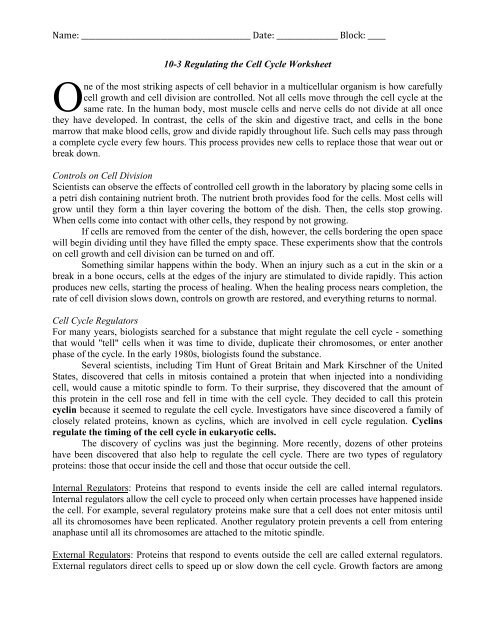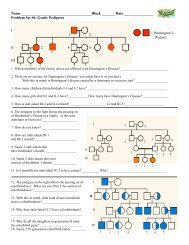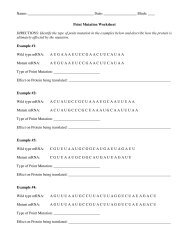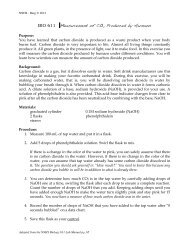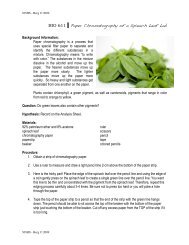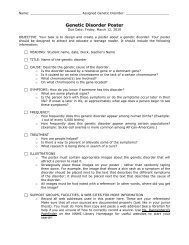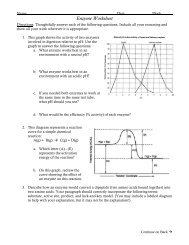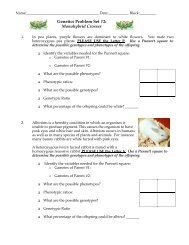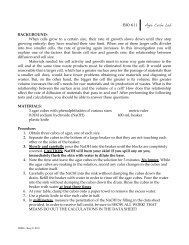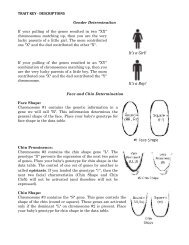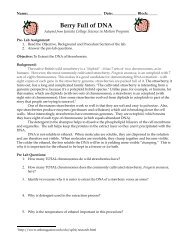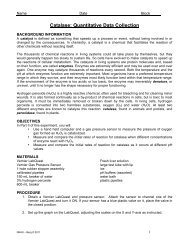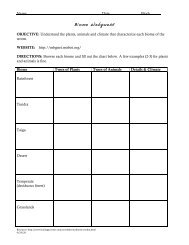10-3.Regulating Cell Cycle - nnhsbergbio
10-3.Regulating Cell Cycle - nnhsbergbio
10-3.Regulating Cell Cycle - nnhsbergbio
Create successful ePaper yourself
Turn your PDF publications into a flip-book with our unique Google optimized e-Paper software.
Name: _______________________________________________ Date: _________________ Block: _____ <br />
<strong>10</strong>-3 Regulating the <strong>Cell</strong> <strong>Cycle</strong> Worksheet<br />
O<br />
ne of the most striking aspects of cell behavior in a multicellular organism is how carefully<br />
cell growth and cell division are controlled. Not all cells move through the cell cycle at the<br />
same rate. In the human body, most muscle cells and nerve cells do not divide at all once<br />
they have developed. In contrast, the cells of the skin and digestive tract, and cells in the bone<br />
marrow that make blood cells, grow and divide rapidly throughout life. Such cells may pass through<br />
a complete cycle every few hours. This process provides new cells to replace those that wear out or<br />
break down.<br />
Controls on <strong>Cell</strong> Division<br />
Scientists can observe the effects of controlled cell growth in the laboratory by placing some cells in<br />
a petri dish containing nutrient broth. The nutrient broth provides food for the cells. Most cells will<br />
grow until they form a thin layer covering the bottom of the dish. Then, the cells stop growing.<br />
When cells come into contact with other cells, they respond by not growing.<br />
If cells are removed from the center of the dish, however, the cells bordering the open space<br />
will begin dividing until they have filled the empty space. These experiments show that the controls<br />
on cell growth and cell division can be turned on and off.<br />
Something similar happens within the body. When an injury such as a cut in the skin or a<br />
break in a bone occurs, cells at the edges of the injury are stimulated to divide rapidly. This action<br />
produces new cells, starting the process of healing. When the healing process nears completion, the<br />
rate of cell division slows down, controls on growth are restored, and everything returns to normal.<br />
<strong>Cell</strong> <strong>Cycle</strong> Regulators<br />
For many years, biologists searched for a substance that might regulate the cell cycle - something<br />
that would "tell" cells when it was time to divide, duplicate their chromosomes, or enter another<br />
phase of the cycle. In the early 1980s, biologists found the substance.<br />
Several scientists, including Tim Hunt of Great Britain and Mark Kirschner of the United<br />
States, discovered that cells in mitosis contained a protein that when injected into a nondividing<br />
cell, would cause a mitotic spindle to form. To their surprise, they discovered that the amount of<br />
this protein in the cell rose and fell in time with the cell cycle. They decided to call this protein<br />
cyclin because it seemed to regulate the cell cycle. Investigators have since discovered a family of<br />
closely related proteins, known as cyclins, which are involved in cell cycle regulation. Cyclins<br />
regulate the timing of the cell cycle in eukaryotic cells.<br />
The discovery of cyclins was just the beginning. More recently, dozens of other proteins<br />
have been discovered that also help to regulate the cell cycle. There are two types of regulatory<br />
proteins: those that occur inside the cell and those that occur outside the cell.<br />
Internal Regulators: Proteins that respond to events inside the cell are called internal regulators.<br />
Internal regulators allow the cell cycle to proceed only when certain processes have happened inside<br />
the cell. For example, several regulatory proteins make sure that a cell does not enter mitosis until<br />
all its chromosomes have been replicated. Another regulatory protein prevents a cell from entering<br />
anaphase until all its chromosomes are attached to the mitotic spindle.<br />
External Regulators: Proteins that respond to events outside the cell are called external regulators.<br />
External regulators direct cells to speed up or slow down the cell cycle. Growth factors are among
Name: _______________________________________________ Date: _________________ Block: _____ <br />
the most important external regulators. They stimulate the growth and division of cells. Growth<br />
regulators are especially important during embryonic development and wound healing. Molecules<br />
found on the surfaces of neighboring cells often have an opposite effect, causing cells to slow down<br />
or stop their cell cycles. These signals prevent excessive cell growth and keep the tissues of the<br />
body from disrupting each other.<br />
Uncontrolled <strong>Cell</strong> Growth<br />
Why is cell growth regulated so carefully? The principal reason may be that the consequences of<br />
uncontrolled cell growth in a multicellular organism are very severe. Cancer, a disorder in which<br />
some of the body's own cells lose the ability to control growth, is one such example. Cancer cells<br />
do not respond to the signals that regulate the growth of most cells. As a result, they divide<br />
uncontrollably and form masses of cells called tumors that can damage the surrounding tissues.<br />
Cancer cells may break loose from tumors and spread throughout the body, disrupting normal<br />
activities and causing serious medical problems or even death.<br />
What causes the loss of growth control that characterizes cancer? The various forms of<br />
cancer have many causes, including smoking tobacco, radiation exposure, and even viral infection.<br />
All cancers, however, have one thing in common: The control over the cell cycle has broken down.<br />
Some cancer cells will no longer respond to external growth regulators, while others fail to produce<br />
the internal regulators that ensure orderly growth.<br />
An astonishing number of cancer cells have a defect in a gene called p53, which normally<br />
halts the cell cycle until all chromosomes have been properly replicated. Damaged or defective p53<br />
genes cause the cells to lose the information needed to respond to signals that would normally<br />
control their growth.<br />
Cancer is a serious disease. Understanding and combating cancer remains a major scientific<br />
challenge, but scientists at least know where to start. Cancer is a disease of the cell cycle, and<br />
conquering cancer will require a much deeper understanding of the processes that control cell<br />
division.
Name: _______________________________________________ Date: _________________ Block: _____ <br />
<strong>10</strong>-3 Regulating the <strong>Cell</strong> <strong>Cycle</strong> Worksheet - QUESTIONS<br />
1. What happens to the cells at the edges of an injury when a cut in the skin or a break in a bone<br />
occurs? ________________________________________________________________________<br />
2. What happens to the rapidly dividing cells when the healing process nears completion? _______<br />
_______________________________________________________________________________<br />
3. What do cyclins regulate? ________________________________________________________<br />
_______________________________________________________________________________<br />
4. What are internal regulators? ______________________________________________________<br />
________________________________________________________________________________<br />
5. Circle the letter of each sentence that is true about external regulators.<br />
a. They direct cells to speed up or slow down the cell cycle.<br />
b. They prevent the cell from entering anaphase until all its chromosomes are attached to the<br />
mitotic spindle.<br />
c. They include growth factors.<br />
d. They prevent excessive cell growth and keep the tissues of the copy from disrupting each<br />
other.<br />
6. What is cancer? _________________________________________________________________<br />
________________________________________________________________________________<br />
7. Complete the sentences.<br />
a. Cancer cells don't respond to signals that regulate ______________________.<br />
b. Cancer cells form masses of cells called __________________________.<br />
c. Cancer cells break loose and spread throughout the ____________________.<br />
8. True or False? Cancer is a disease of the cell cycle. ______________


